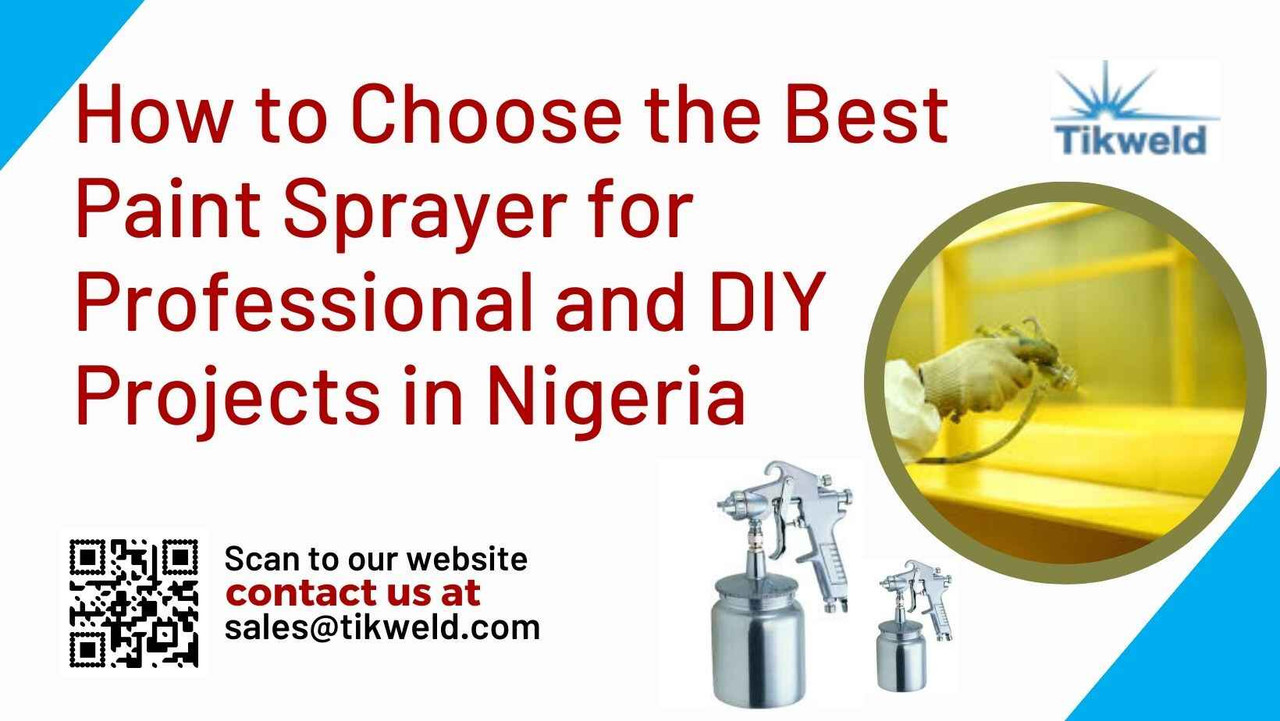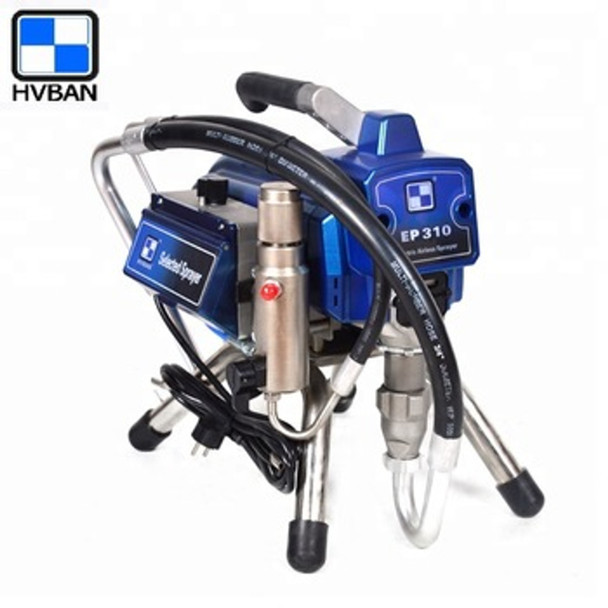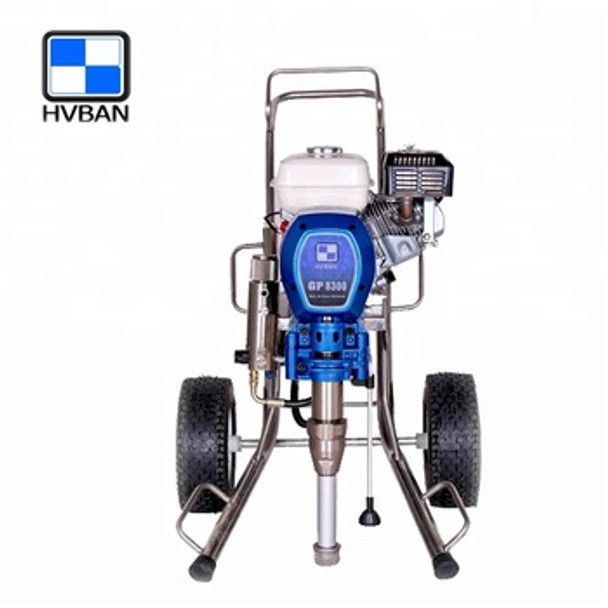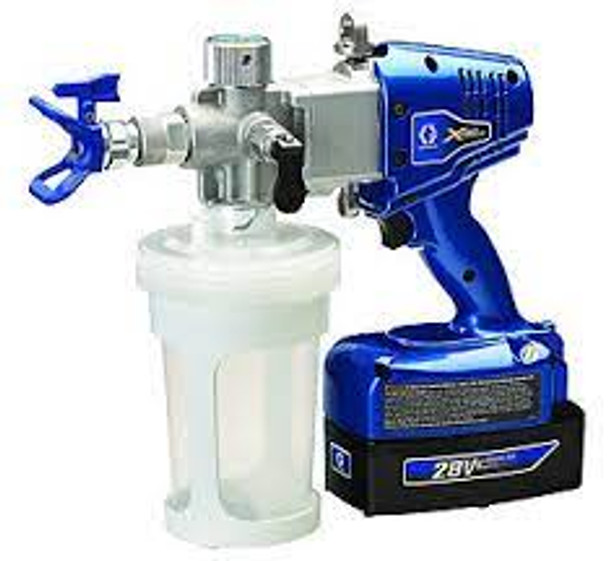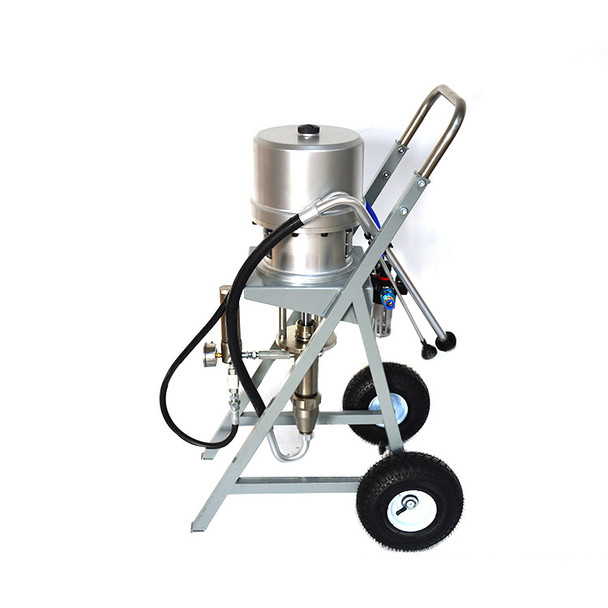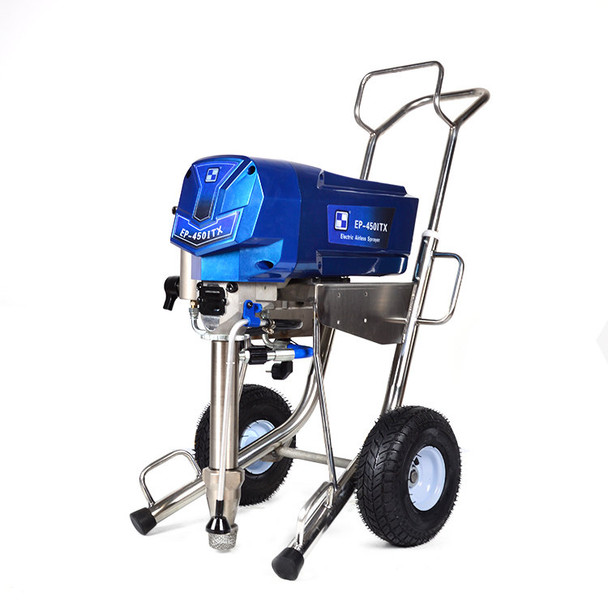How to Choose the Best Paint Sprayer for Professional and DIY Projects in Nigeria
Key Takeaways
- Understand Types of Sprayers: Choose between airless, HVLP, compressed air, or electric sprayers based on your project needs.
- Match Sprayer to Project: Select a sprayer that fits the scale and complexity of your project, whether it's a large commercial job or a small DIY task.
- Consider Paint Type: Ensure compatibility with the type of paint you plan to use (oil-based, water-based, etc.).
- Power Source Matters: Decide between corded or cordless models based on your power needs and mobility preferences.
- Ease of Use: Opt for user-friendly models with adjustable settings, especially for DIY projects.
- Durability: Invest in high-quality, durable sprayers that can withstand Nigeria's climate and frequent use.
- Budget Appropriately: Balance cost with features, choosing the best sprayer within your budget for both professional and personal use.
- Maintenance is Key: Regularly clean and maintain your sprayer to ensure longevity and optimal performance.
Introduction
Painting is a vital aspect of home improvement and professional work, significantly impacting the aesthetics and protection of surfaces. Choosing the right paint sprayer can make a world of difference in achieving a flawless finish, whether you’re a DIY enthusiast or a professional painter. In Nigeria, where the climate and local conditions can influence the choice of equipment, selecting the right paint sprayer becomes even more critical. This guide will walk you through the different types of paint sprayers, essential factors to consider, and tips for maintaining your equipment to ensure you get the best results for your projects.
In Nigeria, where the weather conditions and various project demands can vary greatly, selecting an appropriate paint sprayer is crucial for achieving a high-quality finish and ensuring efficiency. This guide will help you navigate the different types of paint sprayers available, considering factors such as the scale of your project, the type of paint you’re using, and your specific needs.
Whether you’re tackling a large-scale commercial job or a simple home improvement task, understanding how to choose the best paint sprayer will help you make an informed decision, ensuring that your projects are completed with the best possible results.
Airless Sprayer HVBAN EP310
Understanding Different Types of Paint Sprayers
1. Airless Paint Sprayers
Airless paint sprayers work by pumping paint at high pressure through a small nozzle, creating a fine mist that covers surfaces evenly. They are known for their ability to handle thick paints and deliver a smooth, professional finish.
1. Pros:
1. High speed and efficiency for large projects.
2. Excellent coverage on rough surfaces.
3. Minimal brush or roller marks.
2. Cons:
1. Can be challenging to control, leading to overspray.
2. Requires thorough cleaning after use.
3. Typically more expensive.
Best Use Cases:
Ideal for large exterior jobs, fences, and walls. Airless sprayers are preferred for projects requiring high efficiency and coverage over extensive areas.
2. HVLP (High Volume Low Pressure) Paint Sprayers
HVLP sprayers operate by using a high volume of air at low pressure to atomize paint into a fine spray. This type of sprayer offers excellent control over the paint flow and is often used for detailed work.
1. Pros:
1. Superior control and precision.
2. Less overspray compared to airless sprayers.
3. Ideal for fine finishes and detail work.
2. Cons:
1. Slower application compared to airless sprayers.
2. Not suitable for thick paints or large areas.
Best Use Cases:
Perfect for furniture, cabinets, and interior walls where precision and a smooth finish are desired.
Gas Powered Airless Sprayer HVBAN GP8300
3. Compressed Air Paint Sprayers
Compressed air sprayers utilize compressed air to spray paint onto surfaces. These sprayers are commonly used in automotive painting and other applications requiring a smooth finish.
1. Pros:
1. Offers a very smooth, even finish.
2. Good for detailed and intricate work.
2. Cons:
1. Requires a compressor, adding to the cost.
2. Can be cumbersome to set up and use.
Best Use Cases:
Best suited for automotive painting and other applications where a high-quality finish is essential.
4. Electric Paint Sprayers
Electric paint sprayers are powered by electricity and are designed for ease of use and versatility. They are often used for a range of projects from small touch-ups to larger areas.
1. Pros:
1. Versatile and easy to use.
2. Suitable for both small and large projects.
3. Generally affordable.
2. Cons:
1. Power limitations compared to airless or compressed air sprayers.
2. May not handle thicker paints as effectively.
Best Use Cases:
Ideal for both small DIY projects and larger home improvement tasks. Electric sprayers offer a good balance of power and convenience.
Graco Force HD Cordless airless sprayer
Factors to Consider When Choosing a Paint Sprayer
1. Type of Project
Understanding the scope of your project is crucial in choosing the right paint sprayer.
Professional Projects:
Large Scale:
For extensive commercial or residential jobs, airless sprayers are often the best choice due to their efficiency and coverage.
Detailed Work:
HVLP sprayers are preferred for intricate work where precision is key, such as cabinetry and trim work.
Small to Medium Scale:
Electric or HVLP sprayers are generally sufficient for home improvement tasks like painting rooms or furniture.
2. Type of Paint and recommended sprayer.
. Oil-Based Paints:
Airless sprayers handle oil-based paints well due to their high-pressure capabilities.
. Water-Based Paints:
HVLP and electric sprayers work well with water-based paints and are easier to clean.
3. Power Source of Paint sprayers
. Corded Models:
Provide consistent power and are ideal for extensive projects where mobility is less of a concern.
. Cordless Models:
Offer greater mobility and ease of use for smaller projects but may have limitations in terms of power and battery life.
4. Ease of Use
Choosing a sprayer that is user-friendly can make a significant difference, especially for DIY enthusiasts.
- Adjustable Settings:
Look for sprayers with adjustable flow and spray patterns for greater control.
- Ergonomic Design:
A comfortable grip and balanced design help reduce fatigue during prolonged use.
5. Durability and Build Quality
In Nigeria's climate, which can be harsh, investing in a durable paint sprayer is essential.
- Material Quality:
Opt for sprayers made from high-quality materials that can withstand frequent use and adverse weather conditions.
- 2. Brand Reputation:
Consider brands known for their durability and reliability.
6. Price and Budget
Paint sprayers come in a range of prices, and understanding your budget can help narrow down your options.
- Budget Models:
Suitable for occasional use and small projects. These are generally more affordable but may lack some advanced features.
- Mid-Range Models:
Offer a balance between cost and functionality, making them ideal for regular use.
- High-End Models:
Designed for professional use with advanced features and superior build quality.
Pneumatic Airless Sprayer 45:1 HVBAN HB330-45
Top Paint Sprayers Available in Nigeria
Hvban is known for its high-quality airless paint sprayers that deliver professional results. They offer a range of models suitable for both large and small projects.
1. Road Marking Machine HVBAN HB5900
The Road Marking Machine HVBAN HB 5900 is a robust line striping machine with a piston pump, powered by a reliable and renowned HONDA gasoline engine. This powerhouse ensures ample power for even the most demanding jobs. The HB 5900 is perfectly suited for medium to large scale projects on athletic fields and pavements, where its easy maneuverability facilitates quick turns and precise stenciling.
Technical Specifications of HB 5900 Road Marking Airless Paint Sprayer Machine:
- Model: HB 5900
- Maximum Flow: 5L/min
- Maximum Working Pressure: 22.7MPa
- Power Source: Honda gasoline engine, synonymous with durability and power.
- Dynamic Power: 4125W/5.5HP,
- Motor Speed: 3600
- Marking Width: 30cm
- Colour: Blue
- Size: 123*82*84cm
- weight : 146kg
2. Airless Sprayer HVBAN EP310
This Airless Sprayer HVBAN EP310 is specifically designed for the professional painter, equipped with EzControl system and 1300W TEFC Brushless DC motor. It’s the ideal sprayer for people who wants to spray residential areas and light commercial area, interior as well as exterior.
Product Specifications of Airless Sprayer HVBAN EP310:
- Model EP-310
- Max.Delivery Rating (L/Min) 3.1
- Max.Working Pressure (Mpa) 21
- Max.Tip Size (inch) 0.029
- Dynamic Power 2200W / 3HP
- Power Type 220V, 50HZ / 60HZ
- Power Source Electric Motor & Piston Pump
- Wearing Parts Piston Pump, Gasket and Seal
- Power Speed (RPM): 4600
- Net Weight: 24 Kg
- Gross Weight: 26 Kg
3. Electric Piston Airless Sprayers HVBAN EP350
The Electric Piston Airless Sprayers HVBAN EP350 is a professional-grade paint sprayer that can handle a variety of painting projects. It features a smart piston pump that delivers a high-pressure spray of up to 21 Mpa, and a dynamic power of 2200W. It can spray up to 4 liters of paint per minute, and supports a maximum tip size of 0.029 inch. The EP350 is easy to operate, durable, and suitable for both indoor and outdoor use. Whether you need to paint walls, ceilings, floors, fences, or furniture, the EP350 can help you achieve a smooth and even finish.
Product Specifications:
- Name EP350 electric airless sprayer
- Model No. : EP350
- Max flow(L/Min): 4
- Max working pressure (Mpa): 21MPa
- Power type: 220V,50/60HZ
- Max nozzle size (in): 0.033
- Gross Wet: 65kg
Comparison Table: Different Types of Paint Sprayers
| Type of Paint Sprayer | Pros | Cons | Best Use Cases |
| Airless | High speed, efficient, excellent coverage | Challenging control, requires thorough cleaning | Large exterior jobs, fences, rough surfaces |
| HVLP | Superior control, less overspray, fine finishes | Slower application, not for thick paints | Detailed work, furniture, cabinetry |
| Compressed Air | Smooth finish, detailed work | Requires a compressor, cumbersome setup | Automotive painting, intricate designs |
| Electric | Versatile, easy to use, affordable | Power limitations, less effective with thick paints | Small to medium projects, home improvement |
Airless Sprayer MARK V Type HVBAN EP450ITX
Maintenance and Care for Paint Sprayers
Cleaning After Use Proper cleaning is essential to maintain the performance and longevity of your paint sprayer.
1. Airless Sprayers:
Clean the nozzle and pump system thoroughly to remove any residual paint. Flush the system with water (for water-based paints) or a solvent (for oil-based paints).
2. HVLP Sprayers:
Disassemble the nozzle and cup, and clean each part with water or solvent depending on the paint used.
3. Compressed Air Sprayers:
Flush the system with a suitable solvent and clean the nozzle to prevent clogging.
4. Electric Sprayers:
Follow the manufacturer's cleaning instructions, typically involving flushing the system and wiping down components.
Regular Maintenance of Paint Sprayers
Tips Regular maintenance ensures that your sprayer remains in good working condition.
1. Check for Wear and Tear:
Regularly inspect hoses, nozzles, and other components for signs of wear.
2. Replace Parts as Needed:
Replace worn or damaged parts promptly to avoid performance issues.
3. Store Properly:
Store your sprayer in a cool, dry place to prevent damage from environmental conditions.
Common Issues and Troubleshooting of Paint Sprayers
Addressing common problems can help keep your sprayer in optimal condition.
1. Clogged Nozzle:
Clean the nozzle thoroughly or replace it if necessary.
2. Inconsistent Spray Pattern:
Check for blockages in the nozzle or ensure the paint is properly mixed.
3. Low Pressure:
Inspect the hose for leaks or kinks and ensure the pump is functioning correctly.
Related Article
The Best Airless Sprayers in Nigeria 2024 Review
Types of Industrial Painting Techniques: Choosing the Right Approach for Your Facility
Frequently Asked Questions
1. What is the difference between airless and HVLP paint sprayers?
Airless sprayers use high pressure to atomize paint and are ideal for large areas, while HVLP sprayers use a high volume of air at low pressure for precise, detailed work.
2. Can I use an electric paint sprayer for exterior walls?
Yes, electric paint sprayers can be used for exterior walls, especially for smaller to medium-sized projects. For larger projects, an airless sprayer might be more efficient.
3. How often should I clean my paint sprayer?
It is important to clean your paint sprayer immediately after each use to prevent clogs and ensure optimal performance. Regular maintenance is also recommended.
4. What type of paint is best for HVLP sprayers?
HVLP sprayers work best with thinner paints, such as water-based or low-viscosity paints, which flow smoothly through the sprayer.
5. How do I store my paint sprayer properly?
Store your paint sprayer in a cool, dry place, and ensure it is thoroughly cleaned before storage. Disassemble any removable parts and keep them in a dry environment to prevent damage.
Conclusion
Choosing the right paint sprayer is crucial for achieving the best results in both professional and DIY projects. By understanding the different types of sprayers and considering factors like project scale, paint type, and budget, you can make an informed decision that suits your needs. Remember to maintain your equipment regularly to ensure its longevity and performance.
For top-quality paint sprayers and professional advice, check out Tikweld's products and services. Visit Tikweld to explore our range of paint sprayers and get the best tools for your painting projects.

